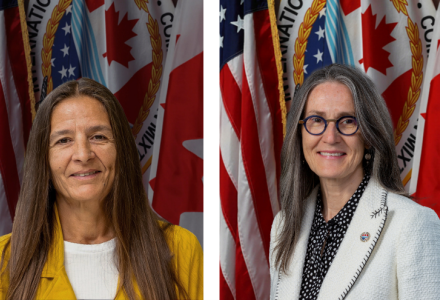
In fall 2022, the International Joint Commission asked “Are the Great Lakes swimmable, drinkable and fishable?” The hundreds of people who answered that question helped inform IJC recommendations to the Canadian and United States federal governments that appear in the new Triennial Assessment of Progress Report on Great Lakes Water Quality.
Public Engagement as Part of the Triennial Assessment of Progress
Public input is an important part of the IJC’s Triennial Assessment of Progress, or TAP. In fall 2022, the IJC heard from people across the Great Lakes basin about how they think the federal governments are making progress toward the Great Lakes Water Quality Agreement’s objectives.
The Commission hosted a series of virtual and in-person meetings, including with Tribal, First Nations and Métis governments and organizations, scientists and coastal managers, municipalities and private industry. People also could complete a survey or submit comments in writing or by email.
The IJC engaged with more than 1,000 people and received almost 500 comments on Great Lakes water quality. Thank you to everyone, from Lake Superior to the St. Lawrence River, who took the time to submit their input.
Swim, Drink, Fish in the Great Lakes
The Canadian and US federal governments’ 2022 State of the Great Lakes (SOGL) report uses nine indicators to assess the ecological condition of each of the Great Lakes, including if it is safe to drink the water, swim at beaches and consume fish. The SOGL outlines that the lakes are generally safe for these activities, with some conditions.
The IJC wanted to know the public’s feelings on the governments’ assessment. The public survey asked respondents how their opinion of the water quality and health of the Great Lakes impacted their use of the lakes for swimming, drinking and fishing. Respondents rated the lakes for these activities on a five-point scale from “very poor” to “very good.”
What did the IJC hear and do these views align with the governments’ assessment? Let’s jump in.
Drink
Tens of millions of people in Canada and the United States drink water from the Great Lakes.
The 2022 SOGL reported that every Great Lake is a “good” source of treated drinking water.
Generally, people agree with the governments’ assessment. Most respondents in Lakes Superior, Michigan and Huron said their lake was “good” or “very good.”
Responses for Lake Erie were more negative. While the majority rated the lake as “good” or “very good,” a significant number of responses rated the lake “poor” or “very poor.”
Lake Ontario saw a more mixed rating, but still had a majority rating of “good” or “very good.” Finally, counter to the governments’ assessment, a majority rated the St. Lawrence River as “fair.” (While the SOGL assess the upper St. Lawrence River with Lake Ontario, the IJC collected input on the upper St. Lawrence River individually.)
In the graphics below, “n” refers to the number of responses for each body of water.

Swim
Swimming at a Great Lakes beach is a favorite summer activity for many. Recreation in the basin—including boating, hunting and fishing—is reportedly responsible for generating more than US$52 billion annually.

The 2022 SOGL states that monitored beaches are generally safe for swimming, while some beaches are occasionally unsafe due to bacteria, such as E. coli. While Lake Erie beaches were assessed as “fair,” the other lakes received a “good.”
Public opinion was a little more mixed. Most respondents for Lake Superior and the St. Lawrence River gave beaches a positive rating, in line with the governments’ assessment. Public opinion was more negative for other lakes, with many respondents rating Lake Erie and Lake Ontario as “fair” to “poor.” Lake Michigan and Lake Huron were generally rated “good” to “fair,” more closely aligned with the governments’ assessment.
Fish
Finally, does the public believe it is safe to eat Great Lakes fish?

According the 2022 SOGL the overall status of fish consumption is “fair,” but improving. Lakes Superior, Michigan, Erie and Ontario were all assessed as “fair,” and Lake Huron as “good.”
For fishing, there is not strong alignment between public opinions and the governments’ assessment based on the IJC’s review. While governments’ assessed Lake Huron as “good” and the St. Lawrence River as “fair,” a majority of respondents rated the pair as “poor” or “very poor.” A majority of respondents for Lakes Superior, Michigan and Erie felt water quality for fishing was “good” or “very good,” versus the governments’ assessment of “fair.”
The Great Lakes Regional Poll
Preparing the TAP is not the only time the IJC seeks the public’s opinion on Great Lakes water quality.
The IJC Great Lakes Water Quality Board’s Great Lakes Regional Poll provides a snapshot of views from residents around the Great Lakes basin on a variety of topics, including the importance of protecting the Great Lakes environmental health and water quality, and perspectives on the need to protect Great Lakes water quality for leisure and recreation, fish and wildlife and the economy. Previously run in 2015, 2018 and 2021, the board is preparing for its fourth poll.
Keep your eyes peeled for more Great Lakes public opinion data in a future issue of the Shared Waters newsletter.

Rachel Wyatt is the communications officer at the IJC’s Great Lakes Regional Office.




